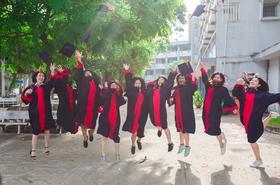School Highlights
Colegio de Cinematografía Artes y Television serves 754 students (68% of students are full-time).
The college's student-teacher ratio of 13:1 is lower than the state community college average of 16:1.
Minority enrollment is 100% of the student body (majority Hispanic), which is less than the state average of 99%.
Quick Facts (2025-26)
- Enrollment: 754 students
- Private-state tuition: $6,560
- Acceptance Rate: 25%
- Student-teacher ratio: 13:1
- Minority enrollment: 100%
- Source: Integrated Postsecondary Education Data System (IPEDS)
Top Rankings
Colegio de Cinematografía Artes y Television ranks among the top 20% of public schools in Puerto Rico for:
Category
Attribute
Selectivity
School Overview
The teacher population of 58 teachers has stayed relatively flat over five years.
Colegio de Cinematografía Artes y Television
(PR) Community College Avg.
Carnegie Classification
Associate's Colleges: Mixed Transfer/Career & Technical-High Traditional
Not applicable, not in Carnegie universe (not accredited or nondegree-granting)
Institution Level
At least 2 but less than 4 years
Four or more years
Institution Control
Private for-profit
Private not-for-profit
Total Faculty
58 staff
70 staff
School Calendar
Student Body
The student population of Colegio de Cinematografía Artes y Television has grown by 12% over five years.
The student-teacher ratio of 13:1 has increased from 11:1 over five years.
The Colegio de Cinematografía Artes y Television diversity score of 0.21 is more than the state average of 0.18. The school's diversity has stayed relatively flat over five years.
Total Enrollment
754 students
588 students
Student-Teacher Ratio
13:1
16:1
# Full-Time Students
516 students
463 students
# Part-Time Students
238 students
125 students
# Enrollment Undergraduate
754 students
323 students
# Full-Time Undergraduate Students
516 students
408 students
# Full-Time Graduate Students
n/a
167 students
# Part-Time Undergraduate Students
238 students
109 students
# Part-Time Graduate Students
n/a
42 students
% Hispanic
88%
90%
% Black
12%
7%
% White
n/a
1%
% Unknown races
n/a
2%
Diversity Score
0.21
0.18
College Completion Rate (Students who graduate in less than 4 years)
50%
50%
College Completion Rate (Students who graduate in 4 years or more than 4 years)
n/a
42%
Average Graduate Earnings (10 Years)
$21,600
$20,600
Tuition and Acceptance Rate
The private state tuition of $6,560 is less than the state average of $6,590. The private state tuition has stayed relatively flat over four years.
Private State Tuition Fees
$6,560
$6,590
% Students Receiving Some Financial Aid
97%
96%
Median Debt for Graduates
n/a
$5,064
Median Debt for Dropouts
n/a
$3,500
Acceptance Rate
25%
77%
SAT Reading
n/a
422
SAT Math
n/a
456
Source: 2024 (or latest year available) Integrated Postsecondary Education Data System (IPEDS)
School Notes
- School Mascot: Wild Boars
- Sample of notable school alumni/alumnae:
- John Doe, Nobel Laureate -
Frequently Asked Questions
How much does Colegio de Cinematografía Artes y Television cost?
Colegio de Cinematografía Artes y Television's private state tuition is approximately $6,560.
What is the acceptance rate of Colegio de Cinematografía Artes y Television?
The acceptance rate of Colegio de Cinematografía Artes y Television is 25%, which is lower than the state average of 77%. Colegio de Cinematografía Artes y Television's acceptance rate is ranked among the top community colleges in Puerto Rico with low acceptance rates.
Who are famous alumni from Colegio de Cinematografía Artes y Television?
Colegio de Cinematografía Artes y Television famous alumni include: John Doe, Nobel Laureate.
What is Colegio de Cinematografía Artes y Television's ranking?
Colegio de Cinematografía Artes y Television ranks among the top 20% of community college in Puerto Rico for: Lowest acceptance rates and Average community college minority breakdown.
Recent Articles

The Rise of Technical and Vocational Training in 2025
Explore the 2025 surge in technical and vocational training—enrollment, policy, costs, and why this path is gaining ground for students and parents.

Stackable Credentials: How Community Colleges Advance Careers
Discover how community colleges use stackable credentials to build career pathways, boost earnings, and enable lifelong learning in 2025.

High-Paying Jobs You Can Get with a Community College Degree
Discover top high-paying careers you can launch in 2025 with a community college (associate) degree and high-growth credentials in tech, healthcare and trades.





